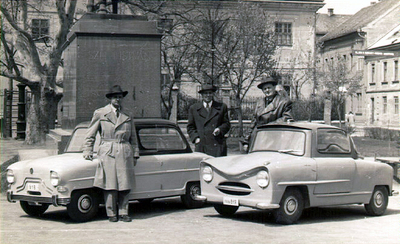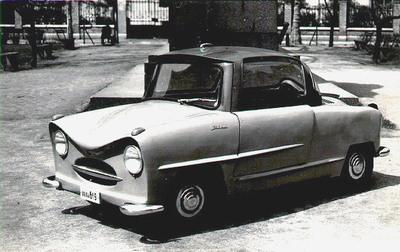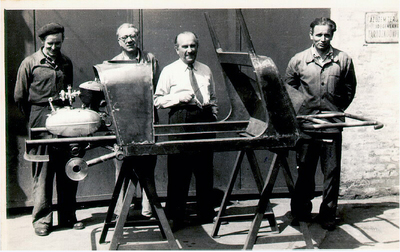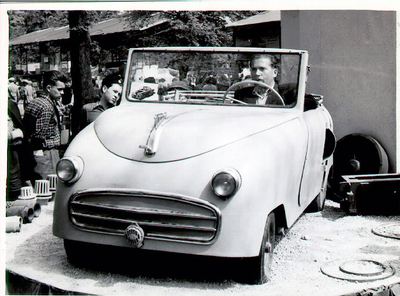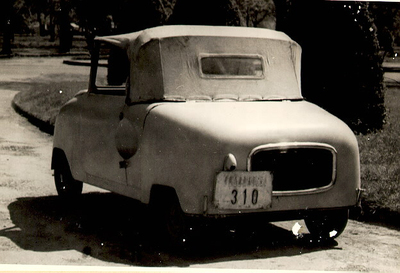Hungarian MicroCars of the 50's
Second part of my historical overview of the post-war Hungarian-made microcars
By Pal Negyesi
By 1952/1953, The Ministry of Metallurgy and Machine Industry in conjunction with the Vehicle Developing Institute started a microcar project. Fuel was now available, only one serious problem lurked on the horizon: the prohibition of COMECON to produce passenger cars. So the project focused on an intermediary type: the closed, four-wheel motorbike, capable of transporting two adults and two children and a few luggages. This was the definition of the microcar.
In 1955 the Ministry commissioned three engineers: Ernô Rubik, the father of the inventor of the Rubik-cube, himself a very talented engineer, Pál Kerekes and Géza Bengyel to start the work on microcars at the Székesfehervári Motorjav¡t¢ V llalat (Székesfehervár Engine Repair Co. Székesfehervár is a city near the capital).
This firm repaired airplanes. Their employees were all gifted in their field. So when the airplane business would have to be shut down, they looked for new activities. They were good in aluminum so any kind of goods made from aluminum counted: from a parabolic antenna through cheese-tub to microcars. One of their engineers, József Horv th already played with the idea of building himself a car. So he brought his plans to the factory and there they started to build the car. József Zappel, another engineer also fancied the idea of a bubble-car so, he too, did some drafts.
In the meantime, an Italian Isetta arrived for inspection, and then a Messerschmitt Kabinroller. The thorough study of the two foreign cars, along with their own ideas led to two unusual microcars in 1955: the Alba Regia of Horváth (Alba Regia was the name of the city during the Roman Empire) and the Balaton of Zappel (Balaton is Hungary's only big lake).
Both cars had aluminum bodies, airplane tail wheels, Pannonia 250 cc motorbike engines. Géza Bengyel who worked as a consultant there, previously was employed in the Csepel motorbike factory where he designed a unique sheet-framed bike with a torsion suspension. This suspension was transferred to the Alba Regia. Balaton received a strange suspension: the arms were held by rubber tags so the vibration was absorbed into the rubber.
The doors of the 2+2 seater Alba Regia opened conventionally. The roof of the Balaton might be pushed backwards with a handle to get access to the cabin, just like in an airplane.
The engines were put to the rear of the cars. The idea of the gearbox was taken from the Isetta, the reverse from the Messerschmitt. For this they added another flywheel to the engine. When the driver wanted to go to the other direction, he or she stopped the engine, pushed a button and started the engine to the other direction. These powertrains were two-stroke so they could puff either way. At the usual 1st of May parade in 1956 four microcars jounced along the cobblestoned streets of Székesfehérvár: the Úttörô, Isetta and the locally made Alba Regia and Balaton.
The Úttörô [Pioneer] was one of the best publicised privately-built microcar. It was designed by János Schadek in Debrecen, east Hungary in 1954. He was a mechanical engineer. While studying at the University he built his first touring car between 1922 and 1927 and in 1930 a Morgan-like tricar. Then he took over the wire-making factory of his father-in-law. After the War, he tried to avoid nationalization, but he couldn't and eventually all the small factories of Debrecen were united into the Locksmith and Iron-founder Company. Schadek became the chief engineer.
He decided to design a two-seater small car. He had some conversations with two locksmiths János Puskás and István Schwanner. Both of them had repaired and assembled airplanes previously. The three experienced men built the Úttörô from scratch.
The car was powered by a Csepel 250 cc motorbike engine, placed on the rear axle. Instead of having a starter, a "kick start" was used. The gear was taken from a motorbike. The small wheels were taken from a barrow. The steering shaft was directly connected to the front axle. This meant a very rude and sensitive driving so it was replaced by rack and pinion steering. The car reached a maximum speed of 80 km/h. It was examined by the Hungarian Research Institute of Automobile Transport in the spring of 1955. After that they sent it back to Debrecen. It was finally sent to Székesfehérvár.
The two Székesfehérvár-made microcars were scrutinized by the Ministry. The Ministry comissioned the Hungarian Research Institute of Automobile Transport to examine the microcars. The Institue already carried out tests on the Úttörô, on another Messerschmitt and on a Goggomobil. The later became the standard to follow: it's 247 cc two-cylinder engine pumped out an impressive 14 bhp. The Hungarian motorbike engines used in the microcars were less powerful. So the Institute stated that either the Goggomobil should be assembled in license or the Alba Regia has a similarity in concept.
The Ministry was not totally convinced with the results so they advertised a microcar competition to find the definite shape. It happened to be just two months before the '56 revolution. In 1957 the Ministry declared there was no winner and then the whole microcar issue was soon dropped. But before the revolution the microcars were shipped to Budapest to a factory which was appointed to manufacture the potential winner of the competition.
During the revolution Zappel and Horváth led the local forces at Székesfehérvár so after the Soviets drowned the revolution in blood Zappel and Horváth had to go. What's more, in the meantime Horváth traveled to Budapest and yelled at the minister of Metallurgy about why his car wouldn't be produced. In early 1957 Horváth left Hungary. Soon Zappel also departed. Horváth died in Switzerland in 1990, his fate remains unknown.
The microcars ended their life in the scrapyard. The Goggomobil was slightly damaged during the revolution and although it was the most promising car it was also destroyed. At least the Alba Regia and Balaton have survived because in 1960 their owners visited one of the constructors for spare parts. After that time I have no information about their whereabouts. The Székesfehérvár factory made another microcar totally from aluminum in late 1957. But then it was only a sideline and soon went down. They made buses afterward and became the part of Ikarus, the Hungarian bus factory in 1963.
With the Trabant and the Wartburg arriving in the late '50s the need for cars was fulfilled in a way. Although the time of one-off creations expired, they never died out: throughout the '60s, '70s, even today there are entrepreneurs who create obscure minicars.




